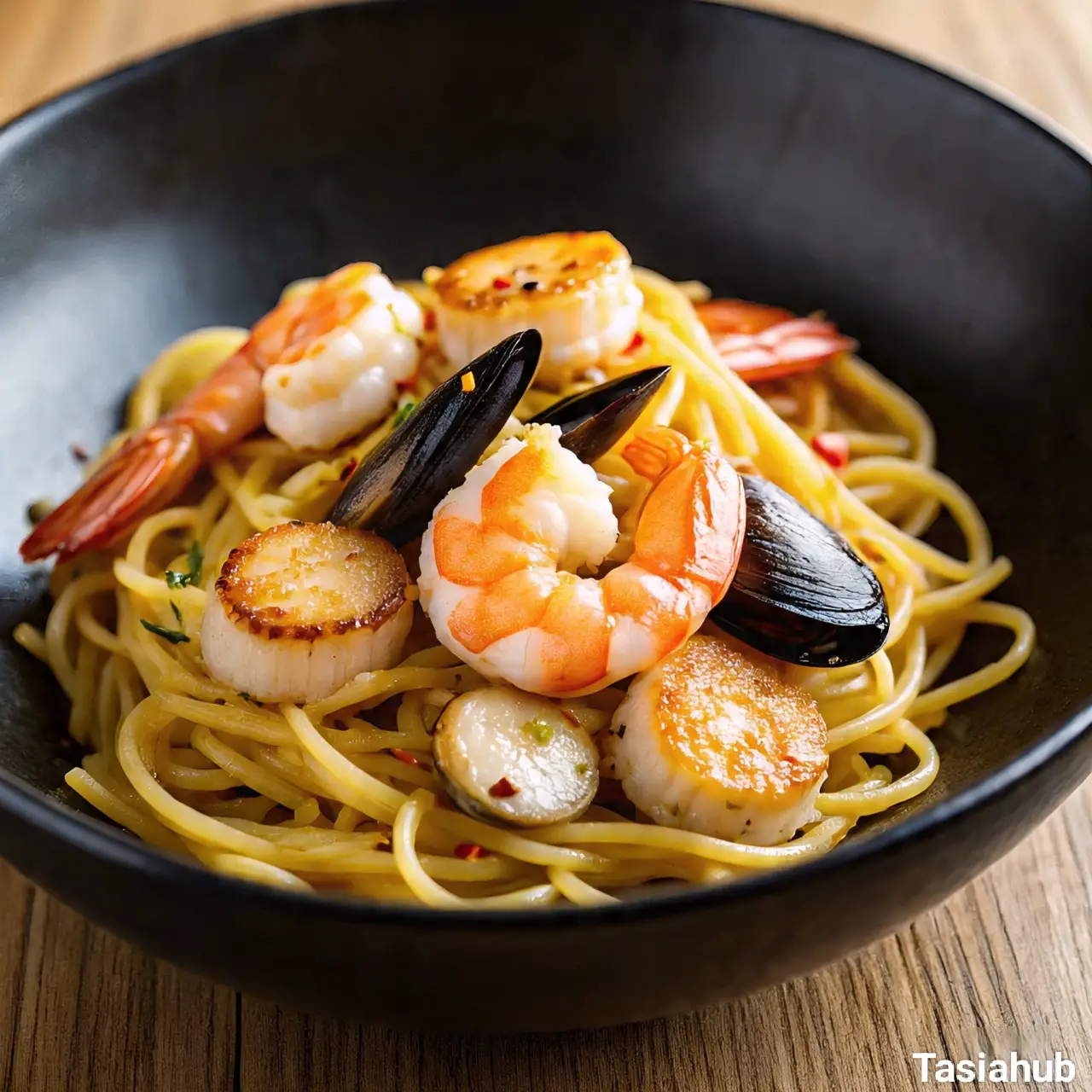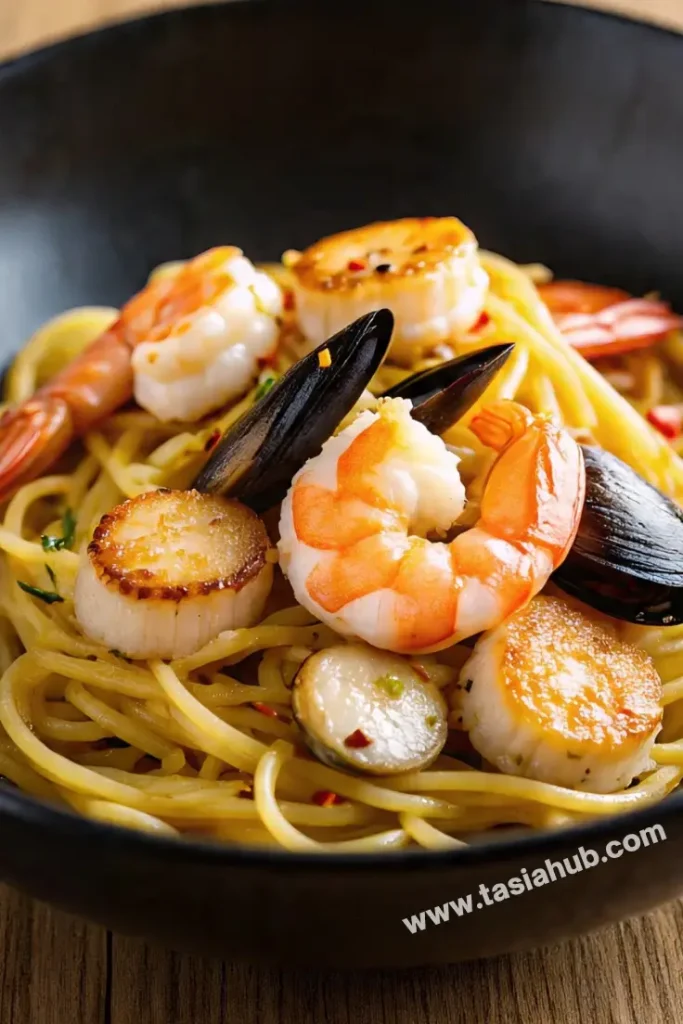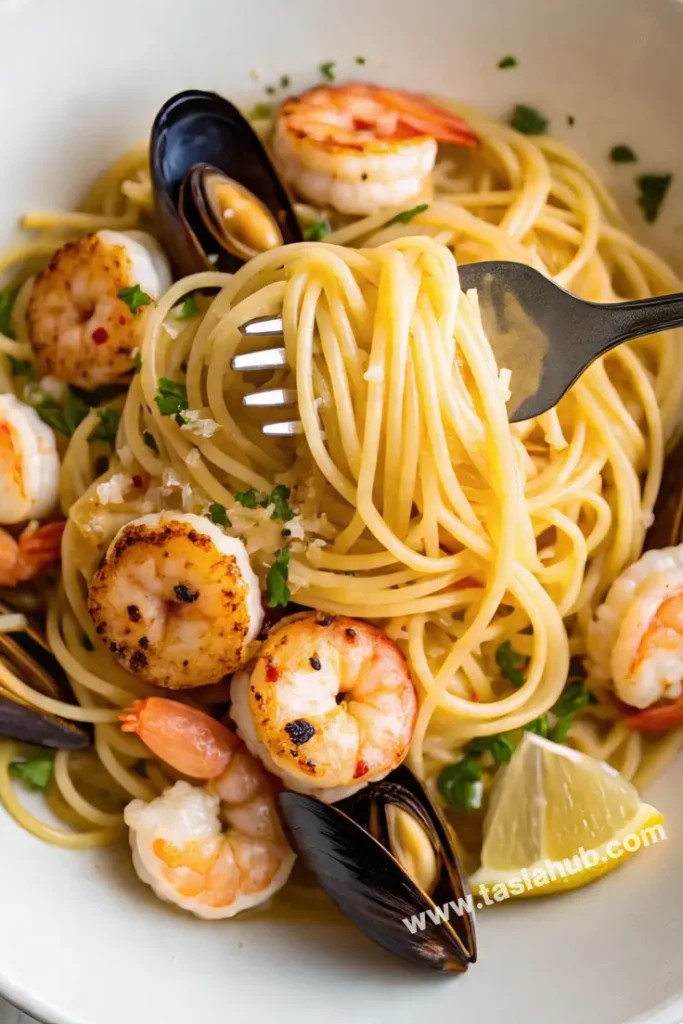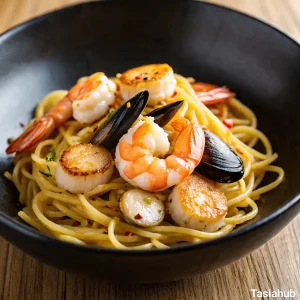Seafood Pasta

I still remember the first time I made seafood pasta—it was an ambitious dinner experiment that almost didn’t happen!
I was craving something restaurant-worthy but didn’t want to spend a fortune dining out. So, I gathered my ingredients, followed a recipe, and hoped for the best. The result? A bowl of creamy, flavorful pasta loaded with shrimp and scallops that made me feel like a professional chef.
Since then, seafood pasta has become one of my go-to meals, especially on special occasions or when I want to treat myself to something indulgent yet simple.
The combination of tender seafood, rich sauce, and perfectly cooked pasta creates a dish that feels luxurious but is surprisingly easy to make. Plus, it’s a great way to bring a taste of the coast to your dinner table, even if you live miles away from the sea.
This post contains affiliate links and I may earn a small commission when you click on the link at no additional cost to you. As an Amazon Affiliate, I earn from qualifying purchases, thank you.
What I love most about this recipe is its versatility. Whether you prefer a creamy garlic sauce, a light lemony broth, or a classic tomato base, seafood pasta can be adapted to suit any preference.
It’s perfect for date nights, dinner parties, or even a quick weeknight meal when you want something a little extra special. And if you’re a seafood lover like me, this dish is an absolute must-try!
What is Seafood Pasta?
Seafood pasta is a flavorful dish that combines fresh seafood with pasta and a delicious sauce. Depending on the recipe, it can include shrimp, scallops, mussels, or even chunks of fish. The sauce varies from creamy and rich to light and tangy, making it a versatile dish for different tastes and occasions.
This dish is popular in Mediterranean and Italian cuisine, where fresh seafood is often paired with simple yet bold flavors like garlic, olive oil, tomatoes, and white wine.
Unlike classic Alfredo, which relies on heavy cream, some versions of seafood pasta use a broth or wine-based sauce to let the natural flavors of the seafood shine. Whether you love creamy dishes or prefer something lighter, there’s a seafood pasta recipe out there for you!
Why You’ll Love It
- Packed with Flavor – The combination of fresh seafood, garlic, white wine, and herbs creates a dish that’s bursting with taste in every bite.
- Easy Yet Impressive – This dish looks and tastes like something from a fancy restaurant, but it’s actually simple to make at home!
- Customizable – You can switch up the seafood, pasta type, or sauce to match your preferences or dietary needs.
- Quick to Prepare – Most seafood cooks in just minutes, making this a great option for a fast yet elegant meal.
- Great for Special Occasions – Whether it’s a romantic dinner, a family gathering, or a celebratory meal, seafood pasta always feels like a treat!
Ingredients
For the Pasta:
- 12 oz (340g) spaghetti or linguine (use gluten-free pasta if needed)
- 1 tbsp salt (for boiling water)
- 1 tbsp olive oil (to prevent sticking)
For the Seafood:
- 8 oz (225g) shrimp, peeled and deveined
- 6 oz (170g) scallops
- 6 oz (170g) mussels, cleaned (optional)
- 1/2 tsp salt
- 1/4 tsp black pepper
For the Sauce:
- 2 tbsp olive oil
- 4 cloves garlic, minced
- 1/2 tsp red pepper flakes (adjust to taste)
- 1/2 cup (120ml) dry white wine (like Sauvignon Blanc)
- 1 cup (240ml) chicken or seafood broth
- 1/2 cup (120ml) heavy cream (optional for a creamy version)
- 1 tbsp lemon juice
- 1/2 tsp lemon zest
- 1/2 cup (40g) grated Parmesan cheese
- 2 tbsp fresh parsley, chopped
Kitchen Tools Needed
- Large Pot – For boiling the pasta; I love using a stainless steel pot for even cooking.
- Colander – To drain the pasta properly.
- Large Skillet or Sauté Pan – Needed for cooking the seafood and making the sauce; a non-stick or stainless steel pan works great.
- Tongs – Useful for tossing the pasta with the sauce.
- Microplane/Zester – For grating Parmesan and zesting the lemon.
- Garlic Press – Makes mincing garlic quick and easy!
Having the right tools makes cooking so much easier, and if you’re looking for a quality skillet, I highly recommend the All-Clad Stainless Steel Pan—it heats evenly and lasts for years!
Cooking Instructions
- Boil the Pasta – Bring a large pot of salted water to a boil. Add the pasta and cook according to package instructions (about 8-10 minutes). Reserve ½ cup of pasta water before draining. Drizzle with olive oil to prevent sticking.
- Sear the Seafood – Heat 1 tablespoon of olive oil in a large skillet over medium-high heat. Add shrimp and scallops, season with salt and pepper, and cook for 2-3 minutes per side until opaque. Remove and set aside.
- Sauté the Garlic – In the same pan, add another tablespoon of olive oil. Stir in minced garlic and red pepper flakes, cooking for about 30 seconds until fragrant. Be careful not to burn the garlic!
- Deglaze with Wine – Pour in the white wine, scraping up any bits stuck to the pan. Let it simmer for 2-3 minutes to reduce slightly. Add the mussels to the pan. Cover with a lid and let them steam for 4-5 minutes until they open. Discard any mussels that remain closed.
- Make the Sauce – Add the broth and bring to a gentle simmer. If using heavy cream, pour it in now and stir well. Cook for another 3-4 minutes until slightly thickened.
- Combine Everything – Add the seafood back into the pan along with the drained pasta. Toss to coat, adding reserved pasta water a little at a time until the sauce clings to the pasta.
- Finish and Serve – Stir in lemon juice, zest, and Parmesan cheese. Sprinkle with fresh parsley and serve immediately!

Tips and Tricks for Success
- Use Fresh Seafood – Fresh seafood gives the best flavor, but if using frozen, thaw and pat it dry before cooking.
- Don’t Overcook the Seafood – Shrimp and scallops cook quickly! Overcooking can make them rubbery.
- Save the Pasta Water – The starchy water helps thicken the sauce and makes it cling better to the pasta.
- Adjust the Spice Level – If you like it spicier, add extra red pepper flakes.
- Use Good-Quality Wine – The flavor of the wine affects the sauce, so use one you enjoy drinking!
- Let the Sauce Simmer – This enhances the flavors and allows the ingredients to meld beautifully.
Ingredient Substitutions and Variations
Substitutions:
- Milk Alternatives – Use almond, oat, or coconut milk instead of heavy cream.
- Gluten-Free – Swap regular pasta for gluten-free pasta.
- Wine Substitute – Use extra broth with a splash of lemon juice if you prefer not to use wine.
Variations:
- Spicy Version – Add extra red pepper flakes or paprika.
- Protein-Packed – Toss in grilled chicken or tofu along with the seafood.
- Veggie Boost – Stir in spinach, cherry tomatoes, or mushrooms for extra nutrition.
Serving Suggestions
- Garlic Bread – The perfect way to soak up the sauce!
- Crisp Green Salad – A fresh, light contrast to the creamy pasta.
- White Wine – Pairs beautifully with the seafood flavors.
- Roasted Vegetables – Adds color and extra nutrition to the meal.
- Grilled Asparagus – A great side for a well-rounded dinner.

Storage and Reheating Instructions
How to Store:
- Store leftovers in an airtight container in the refrigerator for up to 2 days.
- Freezing is not recommended as the seafood can become rubbery when reheated.
How to Reheat:
- Stovetop: Reheat in a pan over low heat, adding a splash of broth or cream to keep it from drying out.
- Microwave: Heat in 30-second intervals, stirring in between to ensure even heating. Adding a little water or milk helps restore the sauce’s texture.
- Oven: Warm at 300°F (150°C) covered with foil for about 10 minutes.
Frequently Asked Questions (FAQs)
1. Can I use frozen seafood?
Yes! Just make sure to thaw and pat it dry before cooking to prevent excess water from diluting the sauce.
2. What’s the best pasta for seafood pasta?
Linguine and spaghetti are classics, but fettuccine and penne also work well.
3. Can I make this without wine?
Absolutely! Substitute with extra broth and a splash of lemon juice or apple cider vinegar.
4. How do I prevent seafood from becoming rubbery?
Cook it just until opaque—overcooking leads to toughness.
I’d love to hear how this turns out for you! Let me know in the comments—do you like your seafood pasta creamy or with a light broth? Happy cooking!
Don’t forget to share your photos on Instagram and tag me (@tasiahub_) or use the hashtag (#tasiahub). I’d love to see your creations!

Seafood Pasta
Equipment
- Large pot
- Colander
- Large skillet or sauté pan
- Tongs
- Microplane/Zester
- Garlic Press
Ingredients
For the Pasta:
- 12 oz 340g spaghetti or linguine (use gluten-free pasta if needed)
- 1 tbsp salt for boiling water
- 1 tbsp olive oil to prevent sticking
For the Seafood:
- 8 oz 225g shrimp, peeled and deveined
- 6 oz 170g scallops
- 6 oz 170g mussels, cleaned (optional)
- 1/2 tsp salt
- 1/4 tsp black pepper
For the Sauce:
- 2 tbsp olive oil
- 4 cloves garlic minced
- 1/2 tsp red pepper flakes adjust to taste
- 1/2 cup 120ml dry white wine (like Sauvignon Blanc)
- 1 cup 240ml chicken or seafood broth
- 1/2 cup 120ml heavy cream (optional for a creamy version)
- 1 tbsp lemon juice
- 1/2 tsp lemon zest
- 1/2 cup 40g grated Parmesan cheese
- 2 tbsp fresh parsley chopped
Instructions
- Boil the Pasta – Bring a large pot of salted water to a boil. Add the pasta and cook according to package instructions (about 8-10 minutes). Reserve ½ cup of pasta water before draining. Drizzle with olive oil to prevent sticking.
- Sear the Seafood – Heat 1 tablespoon of olive oil in a large skillet over medium-high heat. Add shrimp and scallops, season with salt and pepper, and cook for 2-3 minutes per side until opaque. Remove and set aside.
- Sauté the Garlic – In the same pan, add another tablespoon of olive oil. Stir in minced garlic and red pepper flakes, cooking for about 30 seconds until fragrant. Be careful not to burn the garlic!
- Deglaze with Wine – Pour in the white wine, scraping up any bits stuck to the pan. Let it simmer for 2-3 minutes to reduce slightly. Add the mussels to the pan. Cover with a lid and let them steam for 4-5 minutes until they open. Discard any mussels that remain closed.
- Make the Sauce – Add the broth and bring to a gentle simmer. If using heavy cream, pour it in now and stir well. Cook for another 3-4 minutes until slightly thickened.
- Combine Everything – Add the seafood back into the pan along with the drained pasta. Toss to coat, adding reserved pasta water a little at a time until the sauce clings to the pasta.
- Finish and Serve – Stir in lemon juice, zest, and Parmesan cheese. Sprinkle with fresh parsley and serve immediately!
Notes
Nutritional Value (Per Serving – Approximate)
- Calories: 520 kcal
- Protein: 38g
- Carbohydrates: 50g
- Fats: 18g
- Saturated Fat: 6g
- Fiber: 3g
- Sugar: 3g
- Sodium: 750mg
The nutritional information on this website is only an estimate and is provided for convenience and as a courtesy only. The accuracy of the nutritional information for any recipe on this site is not guaranteed. It should not be used as a substitute for a professional nutritionist’s advice.